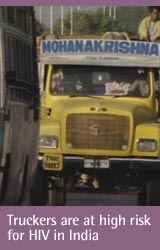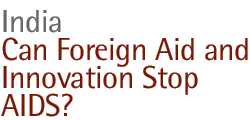Living with HIV (2005)*: 5.7 million (0.9% pop.)
Receiving Drugs (2005): 36,000-67,000 (7% of those who need them)
Est. AIDS Deaths (2005): no data

The details of Balbir Pasha's personal life were plastered for all to read across the teeming streets of Mumbai, India. Signs posted in packed trains suggested he sometimes drank too much and forgot to use a condom. Bright blue and yellow billboards trumpeted his regular visits to Manjula, a favorite sex worker from the city's infamous red light district. Balbir Pasha -- and his intimate habits -- was the talk of the town, and one pressing question preoccupied Mumbai: Would Balbir Pasha get AIDS?
Within a few years, India is poised to replace South Africa as the nation with the most HIV/AIDS infections in the world. Official estimates say more than 5 million people are already infected, but doctors working the frontlines of the epidemic suggest the real tally could be closer to 10 or 12 million. Nationwide, around 1 percent of the adult population is infected, but concentration varies from region to region, and is as high as 10 percent in some villages.
Balbir Pasha was a fictional character created for an AIDS awareness project launched in late 2002. Population Services International, the Washington, D.C.-based nonprofit organization that managed the "Will Balbir Pasha Get AIDS?" campaign, reported that their efforts had reached 80 percent of Mumbai's adults and that calls to the AIDS help hotline number publicized on the Balbir Pasha signs, billboards and commercials increased by 250 percent after the campaign. Throughout India, it is non-governmental efforts like this that are taking the lead in the fight against AIDS.
India is a conservative country where sexual behavior is hidden and the virus has spread most quickly via sex workers and their male clients, often long-distance truck drivers. As late as 2003, the government was denying it had an AIDS problem. Today, India isn't ignoring AIDS, but neither is it at the forefront of anti-HIV efforts.
In 1986, when the first case was diagnosed in a female Indian sex worker, the government initiated committees and investigations, but bureaucracy and budget decisions have hindered efforts. At least 80 percent of health care in India is provided by the private sector, limiting the ability for the government to introduce swift, decisive changes. A labyrinth of paperwork prevents some of the government's own community AIDS treatment centers from qualifying to receive the medicines they desperately need. India is one of only eight nations in the world whose health budget is less than 1 percent of their GDP.
The Indian government's national strategy for tackling AIDS is mostly carried out by the National AIDS Control Organization (NACO). Founded in 1992 and revitalized by new leadership that took over in 1999, NACO, working with other government programs, has streamlined testing, created television and radio spots, hosted concerts, and began student awareness campaigns. But there is an international consensus that these well-intentioned efforts have been too little too late, and India still lacks the serious commitment necessary to face an already massive problem.
Foreign aid -- like that supplied by Population Services International -- is picking up the slack, funding endeavors targeted at keeping real-life Balbir Pashas AIDS-free. A leading presence among these foreign-funded groups is Avahan, headed by Ashok Alexander and funded by The Bill and Melinda Gates Foundation. Alexander speaks frankly about the limits of the current funding for AIDS outreach in India. "It's a bit like trying to hold off a tsunami with an umbrella," he explains. "The umbrella is the amount of resources we have right now to tackle this tidal wave of HIV that's coming 'round. There's about $150 million from all sources, including ours, going into HIV prevention and treatment. And that is completely inadequate given the scale of this epidemic."
As in many other nations, there are signs that HIV/AIDS is moving out of India's obvious high-risk populations -- clustered in the drug-filled red light districts of urban areas -- to become a truly nationwide problem. Heterosexual sex accounts for more than 80 percent of all HIV/AIDS transmissions. An estimated 30 to 60 percent of India's sex workers are infected, along with up to 15 percent of truck drivers, who are the main conveyors of the virus to new locations and populations.
To counter this trend, some approaches to stopping the disease's spread work like the Balbir Pasha campaign, targeting individuals who might frequent the red light districts. Others seek to empower sex workers to protect themselves and their clients, often by sending in peer educators. One successful peer educator program in Kolkata raised condom use from 27 percent in 1992 to 86 percent in 2001. Although the government officially condones these types of education and condom distribution programs, law enforcement agencies still regularly harass these groups.
Across India, stigma makes living with HIV/AIDS exceptionally difficult. Fears about the disease itself are exacerbated by the fact that many of those commonly affected come from groups already at the outskirts of Indian society, those self-identifying as "untouchables" or hijras (eunuchs). A major goal of the Balbir Pasha campaign was simply to get Indians to talk openly about AIDS, a step towards undermining the stigma Ashok Alexander has labeled, "a worse killer than this virus. Because to know that you are HIV positive is a living death."
As India faces the future, one of the nation's greatest hopes is its technological prowess, including its established status as a major drug manufacturer. Cipla, an Indian company with headquarters in Mumbai, pioneered the production of cheap generic AIDS drugs, producing an antiretroviral regimen that costs one-thirtieth of the brand-name version. Despite a known Indian "gray market" for drugs of suspect quality, tests have confirmed that the AIDS generics manufactured by Cipla and other Indian companies meet quality control standards. Provided the World Trade Organization can work out sensible ways to police patents without inflating the prices of these vital medicines, India's drug factories could hold a key to better controlling and treating HIV not only in India, but around the world.
And there is more good news coming out of India. One recent report cited a 35 percent decrease in the prevalence of HIV among 15-to-24-year-olds in southern India, the region hardest hit by the epidemic. The study's authors linked the decline in prevalence to effective prevention and awareness campaigns -- like "Will Balbir Pasha Get AIDS?" -- that reach out to sex workers and their clients.
But can the potential tidal wave of HIV infections be stopped? India is projected to have 20 to 25 million cases of HIV by 2010 -- a national infection rate of 4 to 5 percent. Compared to many African nations where 10 to 20 percent of adults are infected, the prevalence of HIV/AIDS in this country of more than a billion people might still seem like more of a ripple. "But what we have to understand," says Ashok Alexander of Avahan, "is that in states within India, it's only taken a bad monsoon for a government to fall. So we have to look at this as a cyclone epidemic rather than a tidal wave sweeping across India. There will be a set of cyclones that devastate ... clusters of districts within large states. That is enough to ... bring down a government; to destabilize national programs; to put large numbers of people into unemployment; to break the back of an already fragile public health system."
* Note: Figures reflect most recent statistics from UNAIDS and the World Health Organization.











